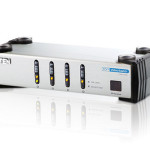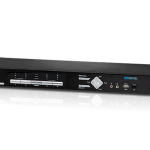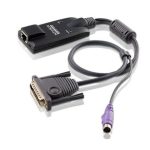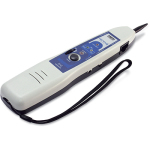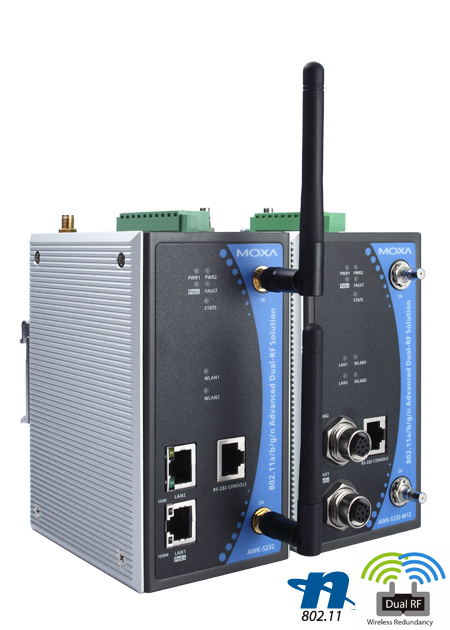 Industrial IEEE 802.11n Dual-Radio Wireless AP/Bridge/Client
Industrial IEEE 802.11n Dual-Radio Wireless AP/Bridge/Client
The AWK-5232 Industrial a/b/g/n Wireless AP/bridge/client is an ideal wireless solution for hard-to-wire situations and all mobile equipment which is connected over a TCP/IP network. It can provide a faster connection and wider range than 802.11g models, especially a noticeably stronger connection at distance. With two independent RF modules, the AWK-5232 allows two independent wireless connections over different frequencies, and supports a great variety of wireless configurations and applications. The AWK-5232 is compliant with the industrial standards and approvals, covering operating temperature, power input voltage, surge, ESD and vibration. The AWK-5232’s two DC power inputs increases the power supply reliability, and it can also be powered via PoE+ for easier deployment.
High Data Rate and Greater Bandwidth
- High-speed wireless connectivity with up to 300 Mbps data rate in each radio module
- MIMO technology improves data throughput via mulitplexed, smart antenna transmissions and receptions
- Channel bonding technology for increased throughput or channel redundancy
- Dual DC power inputs and PoE+
- Immunity against disconnection caused by radio interference
Specifications for Higher Security
- 64-bit and 128-bit WEP (Wired Equivalent Privacy)
- Enable/disable SSID broadcasts
- Power filters for access control
- IEEE/802.11X/RADIUS supported
- WPA/WPA2/802.11i supported
Feature :
Features and Benefits
- IEEE 802.11a/b/g/n compliant
- Dual-radio design for 2.4 GHz and/or 5 GHz bands
- Redundant power inputs and PoE+
- Industrial grade QoS (WMM) and VLAN supported
- Supports client-based Turbo Roaming
- -40 to 75°C operating temperature range (T models)
Specification :
| • WLAN Interface | |
| Standards | IEEE 802.11a/b/g/n for Wireless LAN IEEE 802.11i for Wireless Security IEEE 802.3 for 10BaseT IEEE 802.3u for 100BaseTX IEEE 802.3ab for 1000BaseT IEEE 802.3at for Power-over-Ethernet Plus IEEE 802.1D for Spanning Tree Protocol IEEE 802.1w for Rapid STP IEEE 802.1Q for VLAN |
| Spread Spectrum and Modulation (typical) | • DSSS with DBPSK, DQPSK, CCK • OFDM with BPSK, QPSK, 16QAM, 64QAM • 802.11b: CCK @ 11/5.5 Mbps, DQPSK @ 2 Mbps, DBPSK @ 11 Mbps • 802.11a/g: 64QAM @ 54/48 Mbps, 16QAM @ 36/24 Mbps, QPSK @ 18/12 Mbps, BPSK @ 9/6 Mbps • 802.11n: 64QAM @ 300 Mbps to BPSK @ 6.5 Mbps (multiple rates supported) |
| Operating Channels (central frequency) | US: 2.412 to 2.462 GHz (11 channels) 5.18 to 5.24 GHz (4 channels) EU: 2.412 to 2.472 GHz (13 channels) 5.18 to 5.24 GHz (4 channels) JP: 2.412 to 2.472 GHz (13 channels, OFDM) 2.412 to 2.484 GHz (14 channels, DSSS) 5.18 to 5.24 GHz (4 channels for W52) |
| Security | • SSID broadcast enable/disable • Firewall for MAC/IP/Protocol/Port-based filtering • 64-bit and 128-bit WEP encryption, WPA /WPA2-Personal and Enterprise (IEEE 802.1X/RADIUS, TKIP and AES) |
| Transmission Rates | 802.11b: 1, 2, 5.5, 11 Mbps 802.11a/g: 6, 9, 12, 18, 24, 36, 48, 54 Mbps 802.11n: 6.5 to 300 Mbps (multiple rates supported) |
| TX Transmit Power | 802.11b: 1 to 11 Mbps: Typ. 18 dBm (± 1.5 dBm) 802.11g: 6 to 24 Mbps: Typ. 18 dBm (± 1.5 dBm) 36 to 48 Mbps: Typ. 17 dBm (± 1.5 dBm) 54 Mbps: Typ. 15 dBm (± 1.5 dBm) 802.11a: 6 to 24 Mbps: Typ. 17 dBm (± 1.5 dBm) 36 to 48 Mbps: Typ. 16 dBm (± 1.5 dBm) 54 Mbps: Typ. 14 dBm (± 1.5 dBm) |
| TX Transmit Power MIMO (per connector) | 802.11a/n (20/40 MHz): MCS15 20 MHz: Typ. 13 dBm (± 1.5 dBm) MCS15 40 MHz: Typ. 12 dBm (± 1.5 dBm) 802.11g/n (20 MHz): MCS15 20 MHz: Typ. 14 dBm (± 1.5 dBm) |
| RX Sensitivity | 802.11b: -92 dBm @ 1 Mbps, -90 dBm @ 2 Mbps, -88 dBm @ 5.5 Mbps, -84 dBm @ 11 Mbps 802.11g: -87 dBm @ 6 Mbps, -86 dBm @ 9 Mbps, -85 dBm @ 12 Mbps, -82 dBm @ 18 Mbps, -80 dBm @ 24 Mbps, -76 dBm @ 36 Mbps, -72 dBm @ 48 Mbps, -70 dBm @ 54 Mbps 802.11a: -87 dBm @ 6 Mbps, -86 dBm @ 9 Mbps, -85 dBm @ 12 Mbps, -82 dBm @ 18 Mbps, -80 dBm @ 24 Mbps, -76 dBm @ 36 Mbps, -72 dBm @ 48 Mbps, -70 dBm @ 54 Mbps |
| RX Sensitivity MIMO | 802.11a/n: -68 dBm @ MCS15 40 MHz, -69 dBm @ MCS15 20 MHz, -70 dBm @ MCS7 40 MHz, -71 dBm @ MCS7 20 MHz 802.11g/n: -69 dBm @ MCS15 20 MHz, -71 dBm @ MCS7 20 MHz |
| • Protocol Support | |
| General Protocols | Proxy ARP, DNS, HTTP, HTTPS, IP, ICMP, SNTP, TCP, UDP, RADIUS, SNMP, PPPoE, DHCP |
| AP-only Protocols | ARP, BOOTP, DHCP, STP/RSTP (IEEE 802.1D/w) |
| • Interface | |
| Default Antennas | 4 dual-band omni-directional antennas, 2 dBi, RP-SMA (male) |
| Connector for External Antennas | RP-SMA (female) |
| RJ45 Ports | 2, 10/100/1000BaseT(X), auto negotiation speed, F/H duplex mode, and auto MDI/MDI-X connection |
| Console Port | RS-232 (RJ45-type) |
| Reset | Present |
| LED Indicators | PWR1, PWR2, PoE+, FAULT, STATE, WLAN1, WLAN2, 100M, 1000M |
| Alarm Contact (Digital Output) | 1 relay output with current carrying capacity of 1 A @ 24 VDC |
| Digital Inputs | 2 electrically isolated inputs • +13 to +30 V for state “1” • +3 to -30 V for state “0” • Max. input current: 8 mA |
| • Physical Characteristics | |
| Housing | Metal, IP30 protection |
| Weight | 1.2 Kg |
| Dimensions | 75 x 135 x 105 mm (2.9 x 5.3 x 4.1 in) |
| Installation | DIN-Rail mounting (standard), wall mounting (optional) |
| • Environmental Limits | |
| Operating Temperature | Standard Models: -25 to 60°C (-13 to 140°F) Wide Temp. Models: -40 to 75°C (-40 to 167°F) |
| Storage Temperature | -40 to 85°C (-40 to 185°F) |
| Ambient Relative Humidity | 5% to 95% (non-condensing) |
| • Power Requirements | |
| Input Voltage | 12 to 48 VDC, redundant dual DC power inputs or 48 VDC Power-over-Ethernet Plus (IEEE 802.3at compliant) |
| Connector | 10-pin removable terminal block |
| Power Consumption | 12 to 48 VDC, 1.5 A (max.) |
| Reverse Polarity Protection | Present |
| • Standards and Certifications | |
| Safety | UL 60950-1, EN 60950-1 |
| EMC | EN 301 489-1/17, FCC Part 15 Subpart B, EN 55022/55024, IEC 61000-6-2/4 |
| Radio | EN 300 328, EN 301 893 |
| Note | Please check Moxa’s website for the most up-to-date certification status. |
| • Reliability | |
| MTBF (mean time between failures) | 290,422 hrs |
| • Warranty | |
| Warranty Period | 5 years |
| Details | See www.moxa.com/warranty |

